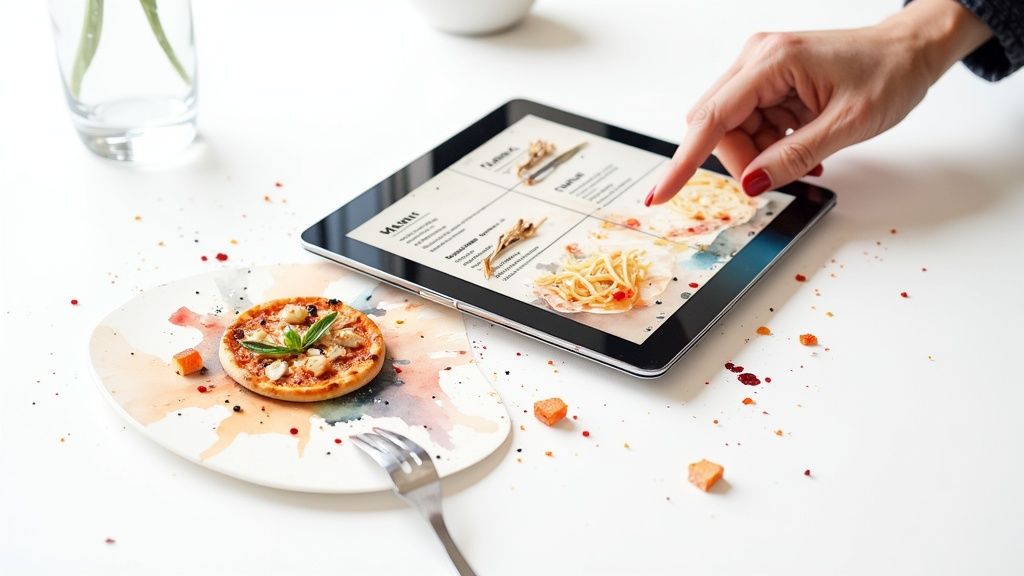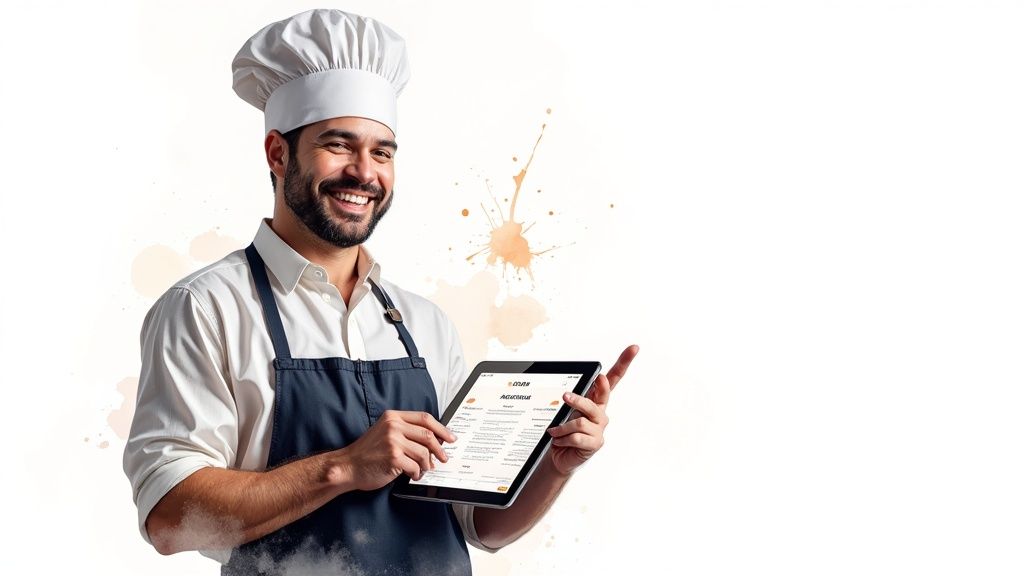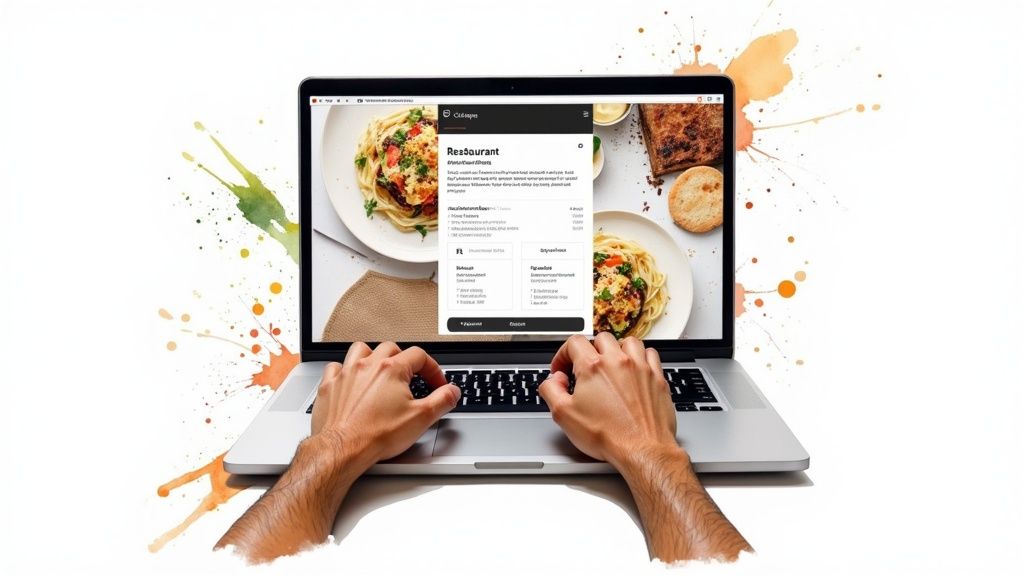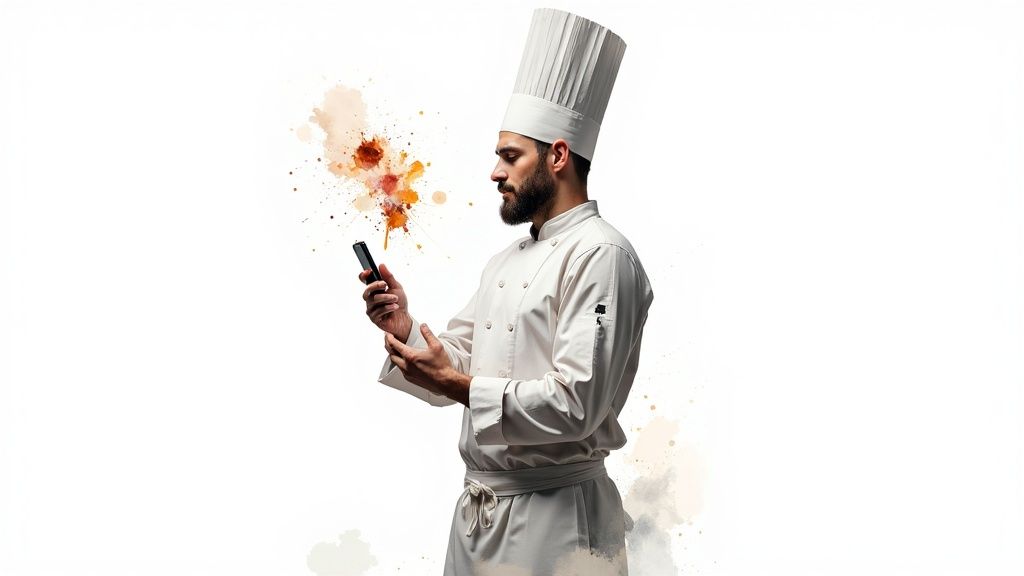Guide to online ordering for restaurants. Choose a system, avoid high fees, and boost profits with direct ordering.

Relying on dine-in traffic alone isn't sustainable for most restaurants. Online ordering for restaurants has shifted from a nice-to-have feature to a core revenue stream, tapping into guests who prefer eating your food at home. This isn't a trend; it's a permanent shift in dining, and adapting is key to growth.
If you're just waiting for guests to walk in, you're leaving money on the table. An online ordering system isn't just about convenience; it's a tool for growing sales and streamlining your kitchen.
Many owners worry online orders will cannibalize their dine-in business. The data shows the opposite. You're capturing a different dining occasion—customers who weren't coming in that night anyway. If you don't offer it, they’ll order from a competitor who does.

You'll notice a bump in your average order value. A busy server might forget to upsell, but an online system never forgets. It will always ask, "Add a side of our famous garlic knots for just $3 more?"
Restaurants with online ordering see an average increase in order value of 15-20%. These automated suggestions add up, boosting revenue without extra labor.
Customers feel less rushed online. They have time to browse the menu and are more likely to add high-margin appetizers, desserts, or drinks.
Every restaurant knows the rush-and-lull cycle. Online ordering helps flatten that curve. Customers often place orders for pickup or delivery before the peak dine-in rush.
This gives your kitchen a head start, allowing them to prep orders during slower periods. The result is:
When a customer orders through a third-party app, they are the app's customer, not yours. You get the order, but the platform keeps the data.
A direct ordering system on your own website flips the script. You get direct access to customer emails and order history. This data is a goldmine for building loyalty and turning a one-time transaction into a lasting relationship. Learn more in our guide on why every restaurant needs its own website.
When offering online ordering, you face a critical choice: third-party marketplaces like Uber Eats and DoorDash, or a direct ordering system on your website. This choice impacts your profitability, customer relationships, and brand control.
Third-party apps offer instant visibility to a large audience, which can feel like a quick win. But that convenience comes at a steep price.
The commission fees are brutal. These platforms take up to a 30% cut from every order, which can wipe out thin profit margins.
Beyond fees, you give up your customer data. The app owns the relationship, meaning you can't run targeted promotions or encourage repeat business. You're renting customers instead of owning them.
You also lose control over the guest experience. If a driver is late or the food arrives cold, your restaurant gets the bad review, even though you had no control over the delivery.
The alternative is a direct ordering system on your website. The biggest benefit? You keep 100% of the revenue, minus standard payment processing fees.
While you're responsible for driving traffic, the long-term payoff is huge:
Here’s how the two models stack up.
For some, the best approach is a strategic combination. Use third-party apps as a marketing tool to attract new customers.
Quick Win: Include a flyer in every third-party delivery bag with a special offer: "Get 15% off your next meal when you order directly from our website!"
This hybrid model uses the visibility of major apps while steering customers toward your commission-free channel. Some systems, like a DoorDash integration, can help manage this relationship within a direct-ordering strategy.
Picking the right system boils down to one question: will this tool make your life easier or create another headache? A great system should plug into your workflow like a natural extension of your team.
This is non-negotiable. If an online order doesn't flow directly into your POS and fire to the kitchen, you're asking for chaos. Manual entry leads to costly mistakes, slower service, and inaccurate sales data.
A system that syncs with your POS makes these problems disappear. The order shows up in the kitchen queue just like one from the dining room. Learn more about why seamless e-commerce and POS integration is so vital.
Your menu changes. You 86 an item or run a weekend special. Your online system has to keep up in real time.

You need to instantly pull an item from your phone or terminal without calling support. Look for a system that lets you:
This control stops you from disappointing a customer who ordered something you just ran out of.
A direct ordering platform is your best tool for building a loyal customer base. Good systems include features to turn first-time buyers into regulars.
Your customer data is a valuable asset. A system that helps you collect and use it to encourage repeat business is essential for growth.
Look for automated email campaigns ("We miss you! Here's 10% off"), simple loyalty programs, and the ability to create discount codes. These tools help you compete without a dedicated marketing department.
You can't manage what you don't measure. Hard data tells you what’s working. A solid platform provides clear reports to help you make smarter decisions.
You should be able to quickly see:
This information helps you fine-tune your menu, schedule staff, and create effective promotions. Because you're handling sensitive data, strong website security best practices are a must.
Getting started doesn't have to be a headache. Follow these practical steps to launch without a hiccup. A smooth ordering process is what builds loyalty.

In fact, 67% of customers who order food online are more likely to visit those same restaurants again. You can explore customer ordering habits and find more insights for additional data.
Not everything on your dine-in menu travels well. A dish that's a masterpiece at the table can become a soggy mess after a 20-minute car ride. Audit every item.
Create a streamlined menu for online customers. It’s better to offer a smaller selection of dishes that you know will be amazing every time.
People eat with their eyes first, especially online. You don't need a professional photographer, but you need good lighting and a clean background.
Your menu descriptions are just as critical. Don't just list ingredients—sell the experience.
Instead of "Chicken Sandwich," try: "Our signature crispy chicken thigh, hand-breaded and fried golden brown, topped with spicy slaw and house-made pickles on a toasted brioche bun."
Also include clear modifiers like "Add cheese" or "Sauce on the side." This reduces errors and improves the guest experience.
A good provider will handle most of the technical setup, but your job is to ensure it flows with your daily operations. Once connected, train your team. A confident team means a smooth launch.
A well-trained team sees online ordering as part of a successful service, not a burden.
Getting your system live is half the battle. Now you need to get the word out. You don't need a massive budget, just a smart plan to get your loyal guests ordering directly from you.
Start inside your restaurant with high-visibility signage. Use table tents, a window cling, and a small flyer stapled to every takeout bag. Every sign needs a clear call to action like, "Skip the line, order online!" and a QR code that takes customers to your ordering page.
Your website needs a big, impossible-to-miss "Order Online" button. Don't bury it. It should be one of the first things a visitor sees, preferably in a bright, contrasting color. When someone is hungry, you have about three seconds to grab their attention.
You already have a direct line to your biggest fans: your email list and social media followers. These people already love your food and are your most likely first-adopters.
Quick Win: Send an email to your customer list announcing the new system with an exclusive discount. 15% off their first direct order creates urgency and gives them a reason to try it immediately.
This initial push builds momentum and proves that ordering directly is the best way to go.
Your social media is a direct sales channel. Announce your launch with posts showing how easy it is to order. A short video of someone ordering on their phone works wonders.
After launch, keep reminding followers about online ordering. Make it a regular part of your content. To turn followers into buyers, you can explore effective e-commerce social media marketing strategies. Consistency is what builds the direct ordering habit.
We talk to restaurant owners daily, and the same questions always come up. Here are some straight answers.
Costs vary. Third-party apps like Uber Eats or DoorDash have no upfront fees but take a 15% to 30% commission from every order.
A direct ordering system typically has a flat monthly subscription, from $50 to $150 per month, plus a small setup fee. The key difference is you keep 100% of the revenue.
Calculate your break-even point. Figure out how many orders you need to cover the monthly fee. You'll see how quickly a direct system pays for itself compared to losing a third of your revenue on every transaction.
Not necessarily. A good system should make your team more efficient. When orders flow directly into your POS, it doesn’t create a separate, chaotic workflow. You might assign one FOH person to manage takeout orders during a rush, but it rarely requires a new hire.
You don't have to be. Modern online ordering for restaurants is built for busy owners, not IT experts. The best platforms are designed to be simple, with intuitive dashboards for daily tasks like 86'ing an item. A good provider will handle the setup and provide responsive support. You run a restaurant; let the tech company handle the tech.
Ready to take control of your takeout and delivery business? Peppr offers commission-free online ordering that integrates seamlessly with your POS, putting your profits and customer relationships back where they belong—in your hands. See how Peppr can work for your restaurant.
